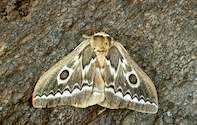
The mopane tree with its distinctive 'butterfly' shaped leaves is a principal food source for many insects and animals.
Over the last few weeks the speckled emperor moth (Gynanisa maia) have hatched in big numbers and have been utilising these leaves. These voracious feeders will be stiff competition for Kruger the more common mopane worm (Gonimbrasia belina), as they are currently stripping the mopane trees of their leaves.
It has been quite a while since these colourful caterpillars have been seen in such numbers throughout the Kruger National Park (KNP). The occasional moths have been collected in the KNP, but even the rangers who have been in Kruger for many years are excited about this outbreak.
The speckled emperor moth belongs to the family Saturniidae. Apart from mopane leaves, the caterpillars are known to feed on Acacia, Elephantorrhiza, (elephant-root) and Combretum (bushwillow) species. The larvae hatch out of white eggs, which are laid on the mopane leaves in clusters of 10 to 12 eggs.
The immature larvae are brown and have large spikes. These then grow into handsome 12 to 13 cm long caterpillars. These luminous green caterpillars have a red and white stripe running the length of the body laterally and are covered with tiny yellow spines and white dots.
Once fully grown the larvae climb down from the mopane trees and pupate in underground chambers, which they must dig. The emergent moth has two small eyespots on the forewing and large coloured eyespots on the hindwing.
These 'eyespots' are used as a defence mechanism to frighten would-be predators. Many adults from the Saturnidae family do not eat during the adult stage and instead have to rely on the fats stored up in their bodies during the larval growth. The adult male speckled emperor moth has the most well developed feathery antenna of the Saturnidae family. This antennae is used to detect specific aroma secreted by the female of the species.
Like many other insects these caterpillars form a very important food source for indigenous people in many regions of Africa. The Shangaan name for them is Gengelengednze. In Malawi (where they are known as Matondo) they are either fried or eaten in stews.
In 1990 the Malawi Department of National Parks recognised that the caterpillars inside the Kasungu National Park could help give people a reason to value the park and its protection so they gave the local people permission to harvest the caterpillars inside the park.
Although this has led to a few logistical problems it still provides a food source and income for the local people when the other food sources dwindle.
Although it is sometimes frightening to see how trees are stripped of leaves by these hungry caterpillars, once the moths have emerged, the trees regrow their leaves and the cycle continues showing us how resilient nature really is.
By Guin Zambatis

